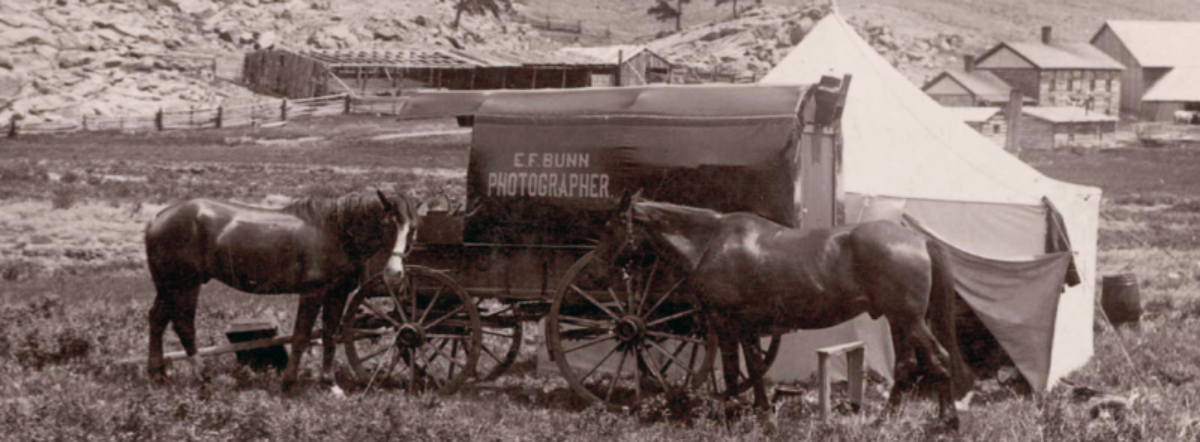
It seems like every western mining region has an area named Gold Hill. For years, researchers have assumed that Edward F. Bunn’s 1891 photographs of Gold Hill were made in Boulder County, Colorado. Today, a drive up the steep, unpaved road to Boulder’s Gold Hill reveals a landscape quite different from that seen in Bunn’s photographs. And with a little digging (pun intended), we can now prove that Bunn’s Gold Hill photographs were not made in Colorado, but in southern Wyoming.

Edward F. Bunn was born in July 1855, in Muskingum County, Ohio, to Elnathan Raymond Bunn, Sr. (1817-1908) and his wife Dorcas Crumrin Bunn (1823-1882). He was the fourth of six children, born into a farming family, an occupation that Edward himself would pursue in Missouri. Edward even patented a cultivator in 1884.
Edward married Mary Ann Dyer (1856-1940) in 1877 in Missouri. The couple visited northern Colorado in March 1885, before moving to Fort Collins that June (Rocky Mountain News, March 13, 1885, p3, c1). Mary Ann’s mother and step-father, William T. Campton, and their two sons also lived in Fort Collins.
It is not known when Edward Bunn learned photography. In 1890 he and Stephen H. Seckner formed a short-lived photography partnership. The following year, Bunn worked alone, out of the old stand he formerly shared with Seckner, as well as his horse-drawn photographic wagon. While he did make portraits, Bunn enjoyed working outdoors and specialized in landscape views. He also offered “one chance in a lifetime” to learn photography. (Loveland Reporter, February 26, 1891, p1,c2)

Health concerns led Bunn to visit Wyoming’s rugged Medicine Bow Mountains in July 1891. The timing was fortuitous, as gold had been discovered in the mountains the previous summer, but too late in the season to fairly assess the prospects. Bunn arrived on the scene and found the miners at work. He could not pass up the opportunity to make photographs, and accepted an assignment from the Board of Trade to photograph the Gold Hill Camp and Battle Lake (The Saratoga Sun, July 14, 1891, page 3, column 2).
The blog’s lead photograph shows a group of well-dressed men standing behind a pile of egg-sized ore nuggets from the Acme Mine and a log structure under under construction. The mine operated double shifts, with plans to ship the ore to Omaha, Nebraska. (The Wyoming Commonwealth, August 9, 1891, p2, c2)
The Saratoga region had seen brief bursts of activity briefly before. Back in 1868, the area supplied railroad ties for the Union Pacific Railroad. Bunn photographed one of the abandoned camps.

Bunn planned on staying in the Saratoga area for about three weeks, but he spent at least an additional three weeks in the region. He set up a temporary studio on the west side of town in late July and early August, making portraits of local citizens, charging $4.00 for popular cabinet-size portraits. (The Saratoga Sun, July 28, 1891, page 4, column 5). These portraits measured 4 x 5-1/2” and were mounted on heavy card stock.
The Platte Valley Lyre reported on July 30, 1891: “E. F. Bunn, a photographer from Fort Collins, has taken a number of fine views of the Battle Lake country during the past week. He has fifteen views in all, giving one a very clear idea of the beauty of this lake on the summit of the Sierra Madres and the magnificent scenery surrounding it. We have seen quite a number of views of the lake, but none of them equaled those taken by Mr. Bunn. He also visited Gold Hill, securing as many photos in that region, but his plates were accidentally injured. He will therefore visit the camp again soon…”
By the late 1890s, the Wyoming gold camps had petered out, as did Bunn’s photographic career. The 1900 federal census lists Edward Bunn as a photographer at St. Cloud, north of Fort Collins. A few years later, he moved to Collbran, Colorado, in Mesa County, where he had success as a dry farmer. Over the years he grew wheat, Concord grapes and sweet corn. He also did carpentry work, enlarging the photo studio of R. C. Phipps (The Plateau Voice, June 2, 1916, page 1, column 1).
Edward F. Bunn died on May 6, 1947. He is buried in Denver’s Fairmount Cemetery.
Additional photographs by E. F. Bunn are available at the Denver Pubic Library’s website: https://digital.denverlibrary.org/digital/
An earlier version of this post appeared in Annuals of Wyoming: The Wyoming History Journal, v84, no. 4 (2014), p20-26.
